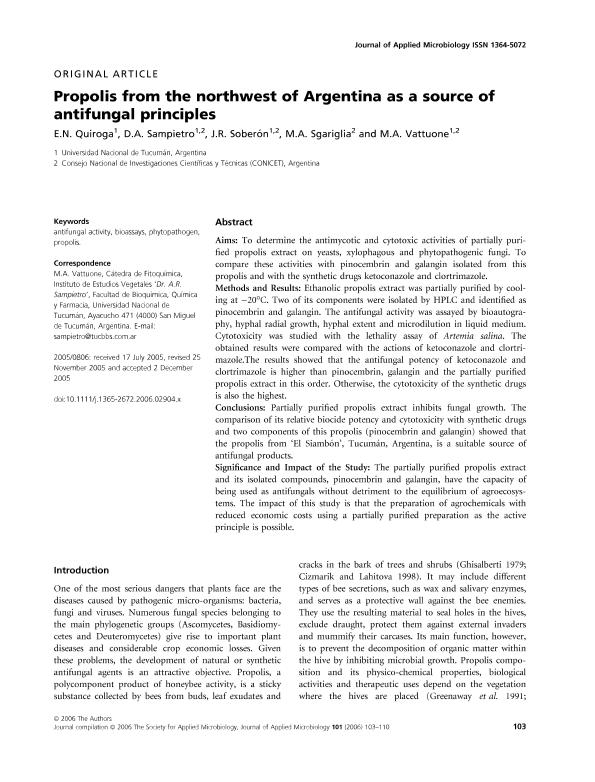Artículo
Propolis from the northwest of Argentina as a source of antifungal principles
Quiroga, Emma Nelly; Sampietro, Diego Alejandro ; Soberon, Jose Rodolfo
; Soberon, Jose Rodolfo ; Sgariglia, Melina Araceli
; Sgariglia, Melina Araceli ; Vattuone, Marta Amelia
; Vattuone, Marta Amelia
 ; Soberon, Jose Rodolfo
; Soberon, Jose Rodolfo ; Sgariglia, Melina Araceli
; Sgariglia, Melina Araceli ; Vattuone, Marta Amelia
; Vattuone, Marta Amelia
Fecha de publicación:
07/2006
Editorial:
Wiley Blackwell Publishing, Inc
Revista:
Journal of Applied Microbiology
ISSN:
1364-5072
Idioma:
Inglés
Tipo de recurso:
Artículo publicado
Clasificación temática:
Resumen
AIMS: To determine the antimycotic and cytotoxic activities of partially purified propolis extract on yeasts, xylophagous and phytopathogenic fungi. To compare these activities with pinocembrin and galangin isolated from this propolis and with the synthetic drugs ketoconazole and clortrimazole. METHODS AND RESULTS: Ethanolic propolis extract was partially purified by cooling at -20 degrees C. Two of its components were isolated by HPLC and identified as pinocembrin and galangin. The antifungal activity was assayed by bioautography, hyphal radial growth, hyphal extent and microdilution in liquid medium. Cytotoxicity was studied with the lethality assay of Artemia salina. The obtained results were compared with the actions of ketoconazole and clortrimazole. The results showed that the antifungal potency of ketoconazole and clortrimazole is higher than pinocembrin, galangin and the partially purified propolis extract in this order. Otherwise, the cytotoxicity of the synthetic drugs is also the highest. CONCLUSIONS: Partially purified propolis extract inhibits fungal growth. The comparison of its relative biocide potency and cytotoxicity with synthetic drugs and two components of this propolis (pinocembrin and galangin) showed that the propolis from ´El Siambón´, Tucumán, Argentina, is a suitable source of antifungal products. SIGNIFICANCE AND IMPACT OF THE STUDY: The partially purified propolis extract and its isolated compounds, pinocembrin and galangin, have the capacity of being used as antifungals without detriment to the equilibrium of agroecosystems. The impact of this study is that the preparation of agrochemicals with reduced economic costs using a partially purified preparation as the active principle is possible.
Palabras clave:
ANTIFUNGAL ACTIVITY
,
BIOASSAYS
,
PHYTOPATHOGEN
,
PROPOLIS
Archivos asociados
Licencia
Identificadores
Colecciones
Articulos(CCT - NOA SUR)
Articulos de CTRO.CIENTIFICO TECNOL.CONICET - NOA SUR
Articulos de CTRO.CIENTIFICO TECNOL.CONICET - NOA SUR
Citación
Quiroga, Emma Nelly; Sampietro, Diego Alejandro; Soberon, Jose Rodolfo; Sgariglia, Melina Araceli; Vattuone, Marta Amelia; Propolis from the northwest of Argentina as a source of antifungal principles; Wiley Blackwell Publishing, Inc; Journal of Applied Microbiology; 101; 1; 7-2006; 103-110
Compartir
Altmétricas



